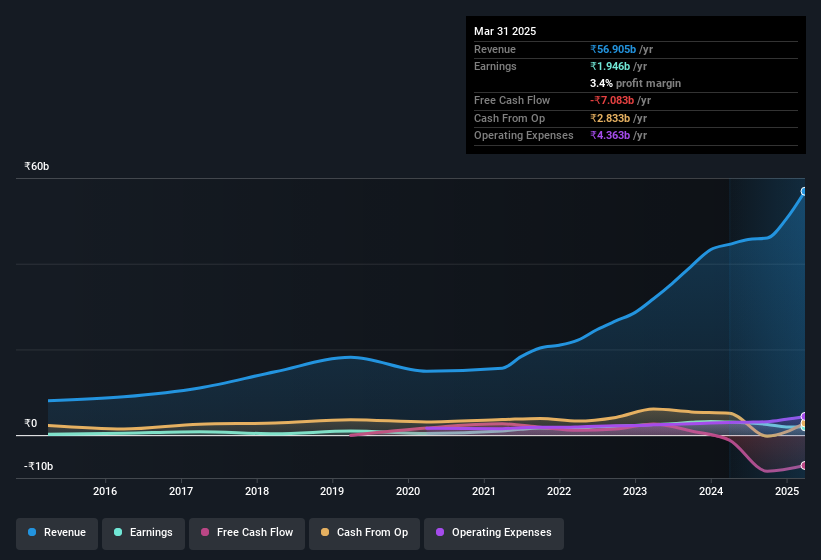We Think That There Are More Issues For Craftsman Automation (NSE:CRAFTSMAN) Than Just Sluggish Earnings
A lackluster earnings announcement from Craftsman Automation Limited (NSE:CRAFTSMAN) last week didn't sink the stock price. Our analysis suggests that along with soft profit numbers, investors should be aware of some other underlying weaknesses in the numbers.
We've discovered 3 warning signs about Craftsman Automation. View them for free.
Examining Cashflow Against Craftsman Automation's Earnings
One key financial ratio used to measure how well a company converts its profit to free cash flow (FCF) is the accrual ratio. In plain english, this ratio subtracts FCF from net profit, and divides that number by the company's average operating assets over that period. The ratio shows us how much a company's profit exceeds its FCF.
That means a negative accrual ratio is a good thing, because it shows that the company is bringing in more free cash flow than its profit would suggest. That is not intended to imply we should worry about a positive accrual ratio, but it's worth noting where the accrual ratio is rather high. That's because some academic studies have suggested that high accruals ratios tend to lead to lower profit or less profit growth.
Craftsman Automation has an accrual ratio of 0.23 for the year to March 2025. Unfortunately, that means its free cash flow fell significantly short of its reported profits. Over the last year it actually had negative free cash flow of ₹7.1b, in contrast to the aforementioned profit of ₹1.95b. Coming off the back of negative free cash flow last year, we imagine some shareholders might wonder if its cash burn of ₹7.1b, this year, indicates high risk. Notably, the company has issued new shares, thus diluting existing shareholders and reducing their share of future earnings.
That might leave you wondering what analysts are forecasting in terms of future profitability. Luckily, you can click here to see an interactive graph depicting future profitability, based on their estimates.
To understand the value of a company's earnings growth, it is imperative to consider any dilution of shareholders' interests. As it happens, Craftsman Automation issued 13% more new shares over the last year. As a result, its net income is now split between a greater number of shares. To talk about net income, without noticing earnings per share, is to be distracted by the big numbers while ignoring the smaller numbers that talk to per share value. Check out Craftsman Automation's historical EPS growth by clicking on this link.
How Is Dilution Impacting Craftsman Automation's Earnings Per Share (EPS)?
As you can see above, Craftsman Automation has been growing its net income over the last few years, with an annualized gain of 19% over three years. But EPS was only up 8.4% per year, in the exact same period. Net income was down 36% over the last twelve months. But the EPS result was even worse, with the company recording a decline of 42%. Therefore, the dilution is having a noteworthy influence on shareholder returns.
If Craftsman Automation's EPS can grow over time then that drastically improves the chances of the share price moving in the same direction. However, if its profit increases while its earnings per share stay flat (or even fall) then shareholders might not see much benefit. For the ordinary retail shareholder, EPS is a great measure to check your hypothetical "share" of the company's profit.
Our Take On Craftsman Automation's Profit Performance
As it turns out, Craftsman Automation couldn't match its profit with cashflow and its dilution means that shareholders own less of the company than the did before (unless they bought more shares). For the reasons mentioned above, we think that a perfunctory glance at Craftsman Automation's statutory profits might make it look better than it really is on an underlying level. So while earnings quality is important, it's equally important to consider the risks facing Craftsman Automation at this point in time. When we did our research, we found 3 warning signs for Craftsman Automation (2 are potentially serious!) that we believe deserve your full attention.
In this article we've looked at a number of factors that can impair the utility of profit numbers, and we've come away cautious. But there are plenty of other ways to inform your opinion of a company. Some people consider a high return on equity to be a good sign of a quality business. So you may wish to see this free collection of companies boasting high return on equity, or this list of stocks with high insider ownership.
New: AI Stock Screener & Alerts
Our new AI Stock Screener scans the market every day to uncover opportunities.
• Dividend Powerhouses (3%+ Yield)
• Undervalued Small Caps with Insider Buying
• High growth Tech and AI Companies
Or build your own from over 50 metrics.
Have feedback on this article? Concerned about the content? Get in touch with us directly. Alternatively, email editorial-team (at) simplywallst.com.
This article by Simply Wall St is general in nature. We provide commentary based on historical data and analyst forecasts only using an unbiased methodology and our articles are not intended to be financial advice. It does not constitute a recommendation to buy or sell any stock, and does not take account of your objectives, or your financial situation. We aim to bring you long-term focused analysis driven by fundamental data. Note that our analysis may not factor in the latest price-sensitive company announcements or qualitative material. Simply Wall St has no position in any stocks mentioned.
About NSEI:CRAFTSMAN
Reasonable growth potential with mediocre balance sheet.
Similar Companies
Market Insights
Community Narratives



